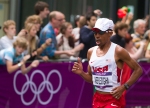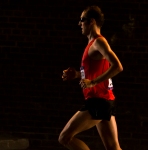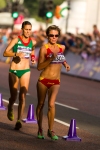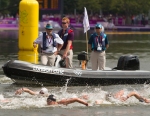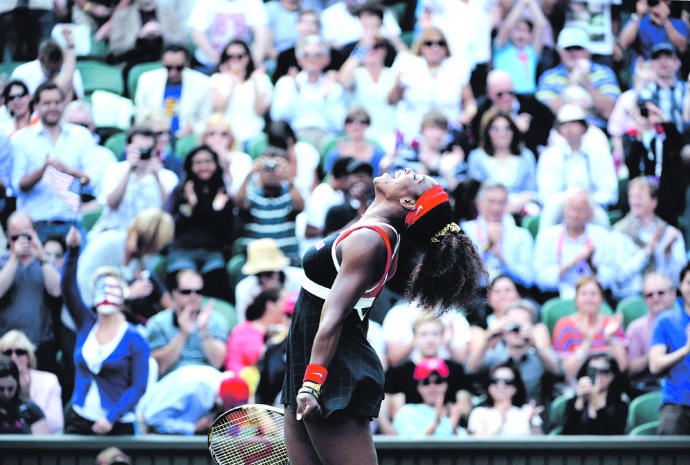
USA’s Serena Williams celebrates after beating Russia’s Maria Sharapova 6-0, 6-1 for the Women’s Singles Tennis gold medal match at Wimbledon, Centre Court for the London 2012 Olympics in London, England on Saturday, Aug. 4, 2012. (Nhat V. Meyer/Mercury News)
Julie Jag
jjag@santacruzsentinel.com
Gabby Douglas, 15, sat in a conference room, surrounded by reporters and Olympic officials with at least 20 years on her. One dusted off the cobwebs and mustered the saliva to ask Douglas, who days earlier became the first African American girl to win the gold medal in the gymnastics individual all-around competition, what she expected the impact of her historic victory to be.
“I’ve always wanted to inspire people,” replied Douglas, as she held court over the group.
“The thing about the Olympics, [there’s] this quote you see: ‘Inspire a Generation.’ You know, now I can check that off my bucket list.”
That moment near the end of my expedition into covering my first Olympics got me thinking about bucket lists. I hadn’t ever really made a physical list of the things I wanted to experience in life, nor taken an inventory. But Douglas’ remarks unlocked a mental file I had apparently stored away in the recesses of my brain. Attending the Olympics in an official capacity was right near the front.
While in the process of fulfilling that wish over the past month, though, I got the opportunity to places checkmarks next to several other life experiences — some of which I didn’t even realize were in the bucket until I’d experienced them for myself. This is the short list:
Serena Williams wins gold with authority
Whatever the reason, this stands out as one the highlights of my Olympic experience. Part of it can be explained by the intimate confines of Wimbledon’s Centre Court, where an entire crowd of 15,000 can share in an inside joke like friends at a dinner party. Part of it related to Williams’ demeanor, more powerful and amped up than ever in her 6-0, 6-1 dismantling of Russia’s Maria Sharapova. What really made it memorable, though, were the post-match antics — Williams dancing on the grass in excitement over her gold-medal performance and the American flag fluttering to the ground in the midst of the national anthem.
USA women’s soccer team gets revenge on Japan
This moment also had more to do with the building and buildup than the game itself. The USA and Japan entered with a tense history, especially from the Americans’ point of view. We were on the losing end of the same matchup for the Women’s World Cup championship in a game that went down to penalty kicks. The USA women made no bones about wanting revenge, plus they had barely escaped Canada in their semifinal. That led to the teams packing 80,200 vocal, flag-waving, sign-hoisting fans — an Olympic record for a women’s game — into Wembley, already one of the world’s iconic soccer venues.
The teams made the game almost as riveting as the anticipation. It was a close, well-played contest full of skillful shots and a couple rub-your-eyes-in-amazement saves by Hope Solo. As far as memories go, of course, it didn’t hurt that the USA came out on top.
Watching the fastest man alive with my own eyes (and seeing him be too slow to escape a gaggle of autograph seeking reporters)
Twice I headed to Olympic stadium to see Usain Bolt prove, again, he’s the fastest man alive. The first time I completed my own sprint, weaving through the thick crowds in my wedged sandals as I tried to get from the jam-packed Stratford train station to the stadium before the 100-meter final. When I got there, I was told the press seating was full. I’m more stubborn than that, though, so I sneaked into the back of an open-air broadcast booth and knelt down until the gun went off. Bolt finished not 100 feet from where I stood, the clear winner, albeit in a close race.
I thought about waiting around to hear his reaction in the press conference. One look at all the time he took “bolting” around the track and the long line of broadcast outlets waiting to interview him, and I figured it would be midnight and he would be exhausted, before the lowly print media got their time with him. Little did I know he planned to stay up until 3 a.m. celebrating with members of the Swedish handball team.
The second time I saw him may have been his last Olympic race. He was gunning for a trifecta by adding the 4×100 to his golds in the 100 and 200. Luckily, I was already at the stadium to cover the women’s 800 final and had snagged a nearly front-row seat. The seat became even better when I discovered that to my right sat an amicable reporter for the London paper The Sun, who happened to be a veritable expert on Bolt, having just finished writing a biography on the runner.
The race was riveting. Team USA and Jamaica quickly emerged as the leaders, but the chance of disaster cropped up at every handoff [in fact, the third-place Canadian team was disqualified for an illegal one]. It came down to the final leg, with the USA’s Ryan Bailey and Jamaica’s Bolt — who doesn’t usually run the anchor leg — taking the batons at the same time. But in a head-to-head footrace, Olympic rookie Bailey, who took fifth in the open 100, couldn’t keep up. Bolt not only broke the tape first, but had the consciousness of mind to immediately form an “M” atop his head in tribute to his friend and adored British distance runner Mo Farah, a two-time gold medalist in London.
The press conference that followed more than an hour later proved with the wait. In fact, it might have been more of a spectacle than the actual race. In it, Bolt’s relay teammate Yohan Blake said of the team: “We are not normal guys. We are from space, I am from Mars.” In a more bizarre outburst, “journalists” from around the globe asked Bolt everything from how did he expect to live a normal life now that, as they put it, he is “truly and by far the greatest athlete to ever live” to whether he would tweet a picture if he found himself in the company of Norwegian women’s handball players that night. As the capper, at least a dozen of these “journalists” rushed the stage after the conference to ask for autographs, while the rest of us cringed.
Feeling the bond of beach volleyball’s gold medal winners (even as the floor falls out from under them)
Standing on top of the podium together for the third time in as many Olympics, Kerri Walsh and Misty May-Treanor still couldn’t hold back the tears during the playing of the “Star Spangled Banner.” The best known beach volleyball players in the world went out on top, and this time they did it the hard way.
Life had changed so much for the two of them since winning in Athens and Beijing — two kids for Walsh, an Achilles injury for May-Treanor — that they needed couples therapy to get through it. Like any relationship worth fighting for, though, the tests only brought them closer, and that was clear in their cooperation on the court.
It was illustrated even more not 30 minutes after the medal ceremony, when they found themselves on rock-bottom once again. Actually, it was plywood bottom.
The floor of the packed “mixed zone” interview area collapsed under the weight of the unexpected mass of reporters who showed up to cover a sport they could no longer ignore now that the duo had hammered harder than one of Walsh’s spikes into the national spotlight. Walsh managed to hop to level ground and she quickly helped her teammate out of the hole she’d fallen into.
Hey, what are partners for?
“The bond we have and understanding we have for each other is so special,” May-Treanor said. “Kerri said it a couple of times, the first two medals, I think it was more volleyball. The friendship we had was there, but it was all volleyball, volleyball. This was so much more about the friendship, the togetherness, the journey, and volleyball was just a small part of it.”
Holding a historic Olympic medal
The Olympics revolves around medals — those who get one and those who don’t. Still, it didn’t occur to me to want to get a close look at one until Abby Johnston, half of the duo that won silver in 3-meter synchronized diving competition, noted how heavy her hardware was during a post-win interview.
How heavy is it? This question led to one of my coolest first-person experiences. There is something magical about a medal, even a silver one. They’re a piece of art and yes, they are heavy. In fact, they weigh about 14 ounces.
Somehow, though, they carry more weight when put into perspective. It was the United States’ first medal in synchronized diving since it became a sport in 2000.
Experiencing the pride of a country (or what moved Mo Farah)
All we heard heading into London for the Olympics was what a disaster they were going to be. The masses weren’t happy about having to pay for these frivolous stadiums and improvements to the train system, especially during an economic downturn. Then, once we got there, they weren’t happy about being turned away while empty seats glared at them from the TV screen. Making matters much worse, several days of competition passed without the Brits bringing home a single gold. Panic started to set in.
But on Day 6, a couple of female rowers broke the golden spell for the host country. Three days later, local darling Jessica Ennis nearly brought down Olympic stadium when she won the heptathlon. It bolstered the Brits’ the national spirit, uniting them in ways even they didn’t expect. When the medals started piling up, each one dusted off a little more pride. Londoners even started talking to each other on the subway, which apparently never happens.
By the time Mo Farah raced to victory in the 5,000 on the eve of the close of the Games, the country practically glowed with glory. They sent the Somali runner — considered by many a true symbol of the nations-uniting purpose of the Games — and the Olympics out with ear-rattling cheers that clanged through the 80,000-seat Olympic stadium.
Nice thing was, when they weren’t cheering for the home team, they respectfully applauded and lauded outstanding athletes from other countries, even the big, bad USA.


